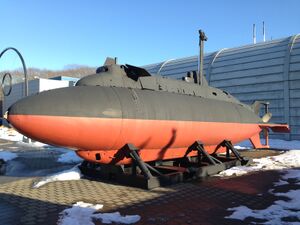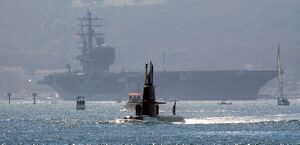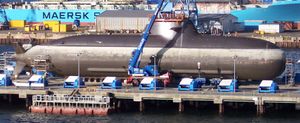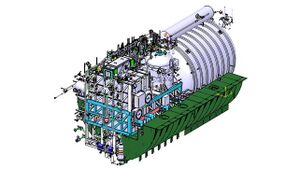دفع لا هوائي
الدفع اللاهوائي (Air-independent propulsion، اختصاراً AIP) أو الطاقة اللاهوائية (Air-independent power)، هي أي تقنية دفع بحري تسمح لغواصة غير نووية بالعمل دون الوصول إلى الأكسجين الجوي (عن طريق الصعود إلى السطح أو استخدام أنبوب التنفس). يمكن لتقنية الدفع اللاهوائي أن تعزز أو تحل محل نظام الدفع بالديزل والكهرباء للسفن غير النووية.
الغواصات الحديثة غير النووية قد تكون أكثر سرية من الغواصات النووية؛ على الرغم من أن بعض مفاعلات الغواصات الحديثة مصممة للاعتماد على الدورة الطبيعية، فإن معظم المفاعلات النووية البحرية تستخدم مضخات لتدوير سائل تبريد المفاعل باستمرار، مما يؤدي إلى توليد قدر من الضوضاء القابلة للكشف.[1][2] من ناحية أخرى، يمكن للغواصات غير النووية التي تعمل البطارية أو نظام الدفع اللاهوائي أن تكون صامتة تقريباً. وفي حين لا تزال التصميمات التي تعمل بالطاقة النووية تهيمن على أوقات الغمر والسرعة والمدى والأداء في أعماق المحيطات، فإن الغواصات الهجومية الصغيرة عالية التقنية غير النووية يمكن أن تكون فعالة للغاية في العمليات الساحلية وتشكل تهديدًا كبيرًا للغواصات النووية الأقل تخفياً وأقل قدرة على المناورة.[3]
يتم تنفيذ نظام الدفع اللاهائي عادةً كمصدر مساعد، مع التعامل مع محرك الديزل التقليدي للدفع السطحي. تولد معظم هذه الأنظمة الكهرباء، والتي بدورها تدفع محركاً كهربائياً للدفع أو تعيد شحن البطاريات. كما يستخدم النظام الكهربائي للغواصة لتوفير "خدمات الفندق" - التهوية والإضاءة والتدفئة وما إلى ذلك - على الرغم من أن هذا يستهلك قدراً صغيراً من الطاقة مقارنة بتلك المطلوبة للدفع.
يمكن تركيب نظام الدفع اللاهوائي في هياكل الغواصات الحالية عن طريق إدخال قسم إضافي من الهيكل. لا يوفر الدفع اللاهوائي عادةً القدرة على التحمل أو القدرة على استبدال الدفع المعتمد على الغلاف الجوي، لكنه يسمح بقدرة تحمل أطول تحت الماء من الغواصة ذات الدفع التقليدي. توفر محطة الطاقة التقليدية النموذجية 3 ميجاواط كحد أقصى، ومصدر الدفع اللاهوائي حوالي 10% من ذلك.[بحاجة لمصدر] تكون قوة دفع الغواصة النووية عادة أكبر بكثير من 20 ميجاواط.
تستخدم البحرية الأمريكية رمز تصنيف الهيكل "SSP" للإشارة إلى القوارب التي تعمل بنظام الدفع اللاهوائي، مع الاحتفاظ برمز "SSK" للغواصات الهجومية الكلاسيكية التي تعمل بالديزل والكهرباء.[أ]
==التاريخ==إستينيو 2

في تطوير الغواصات، كانت مشكلة إيجاد أشكال مرضية للدفع تحت الماء مستمرة. كانت الغواصات الأولى تعمل بالطاقة البشرية مع مراوح يدوية، والتي كانت تستهلك الهواء بسرعة داخلها؛ كان على هذه السفن أن تتحرك لجزء كبير من الوقت على السطح مع فتحات مفتوحة، أو استخدام شكل من أشكال أنبوب التنفس، وكلاهما خطير بطبيعته ويؤدي إلى عدد من الحوادث المبكرةلاحقاً، استخدمت السفن التي تعمل ميكانيكيًا الهواء المضغوط أو البخار، أو الكهرباء، والتي كان يجب إعادة شحنها من الشاطئ أو من محرك هوائي على متنها.
The earliest attempt at a fuel that would burn anaerobically was in 1867, when Spanish engineer Narciso Monturiol successfully developed a chemically powered anaerobic or air independent steam engine.[4][5]
In 1908 the Imperial Russian Navy launched the submarine Pochtovy, which used a gasoline engine fed with compressed air and exhausted under water.
These two approaches, the use of a fuel that provides energy to an open-cycle system, and the provision of oxygen to an aerobic engine in a closed cycle, characterize AIP today.
الأنواع
Air independent propulsion (non-nuclear) can take various forms. All currently active AIP submarines require oxygen for AIP,[مطلوب توضيح] which is commonly stored as a liquid (LOX). AIP submarine range is primarily limited by the amount of LOX it can carry.[6]
نظم الدوائر المفتوحة

During World War II the German firm Walter experimented with submarines that used high-test (concentrated) hydrogen peroxide as their source of oxygen under water. These used steam turbines, employing steam heated by burning diesel fuel in the steam/oxygen atmosphere created by the decomposition of hydrogen peroxide by a potassium permanganate catalyst.
Several experimental boats were produced, though the work did not mature into any viable combat vessels. One drawback was the instability and scarcity of the fuel involved. Another was that while the system produced high underwater speeds, it was extravagant with fuel; the first boat, V-80, required 28 tons of fuel to travel 50 ميل بحري (93 كيلومتر), and the final designs were little better.
After the war one Type XVII boat, U-1407, which had been scuttled at the end of World War II, was salvaged and recommissioned into the Royal Navy as إتشإمإس Meteorite. The British built two improved models in the late 1950s, إتشإمإس Explorer and إتشإمإس Excalibur. Meteorite was not popular with its crews, who regarded it as dangerous and volatile; she was officially described as 75% safe.[7] The reputations of Excalibur and Explorer were little better; the boats were nicknamed Excruciater and Exploder.[8]
The Soviet Union also experimented with the technology and one experimental boat was built which utilized hydrogen peroxide in a Walter engine.
The United States also received a Type XVII boat, U-1406, and went on to begin two AIP submarine projects. Project SCB 66 developed an experimental midget submarine, X-1, which was launched in September 1955. It was originally powered by a hydrogen peroxide/diesel engine and battery system until an explosion of her hydrogen peroxide supply on 20 May 1957. X-1 was later converted to a diesel-electric.[9][10]
The second U.S. Navy project was of a full sized AIP submarine under SCB 67 in 1950, later SCB 67A. This submarine, designated SSX, would have one of three propulsion plants under development: a Walther open cycle hydrogen peroxide plant (termed Alton), a liquid oxygen steam plant (Ellis), and an AIP gas turbine (Wolverine). By late 1951 the Navy realized that while the competing nuclear designs were heavier due to shielding, they were more compact than the three AIP plants: the SSX would be longer than the SSN by nearly 40 feet. The SSN would likely be quieter and less complicated than the AIP technology of this time. By 1952 the nuclear reactors were so far along in development it appeared that the SSX submarine would not be needed as a stopgap. The project was cancelled on 26 October 1953.[11]
The USSR and the UK, the only other countries known to be experimenting with the technology at that time, also abandoned it when the US developed the nuclear reactor small enough for submarine propulsion. Other nations, including Germany and Sweden, would later recommence AIP development.
It was retained for propelling torpedoes by the British and the Soviet Union, although hastily abandoned by the former following the إتشإمإس Sidon tragedy. Both this and the loss of the Russian submarine Kursk were due to accidents involving hydrogen peroxide propelled torpedoes.
محركات الديزل ذات الدائرة المغلقة
This technology uses a submarine diesel engine which can be operated conventionally on the surface, but which can also be provided with oxidant, usually stored as liquid oxygen, when submerged. Since the metal of an engine would burn in pure oxygen, the oxygen is usually diluted with recycled exhaust gas. Argon replaces exhaust gas when the engine is started.
In the late 1930s the Soviet Union experimented with closed-cycle engines, and a number of small M-class vessels were built using the REDO system, but none were completed before the German invasion in 1941.
During World War II the German Kriegsmarine experimented with such a system as an alternative to the Walter peroxide system, designing variants of their Type XVII U-boat and their Type XXVIIB Seehund midget submarine, the Type XVIIK and Type XXVIIK respectively, though neither was completed before the war's end.
After the war the USSR developed the small 650-ton Quebec، طراز submarine, of which thirty were built between 1953 and 1956. These had three diesel engines—two were conventional and one was closed cycle using liquid oxygen.
In the Soviet system, called a "single propulsion system", oxygen was added after the exhaust gases had been filtered through a lime-based chemical absorbent. The submarine could also run its diesel using a snorkel. The Quebec had three drive shafts: a 32D 900 bhp (670 kW) diesel on the centre shaft and two M-50P 700 bhp (520 kW) diesels on the outer shafts. In addition a 100 hp (75 kW) "creep" motor was coupled to the centre shaft. The boat could be run at slow speed using the centreline diesel only.[12]
Because liquid oxygen cannot be stored indefinitely, these boats could not operate far from a base. It was dangerous; at least seven submarines suffered explosions, and one of these, M-256, sank following an explosion and fire. They were sometimes nicknamed cigarette lighters.[13][استشهاد ناقص] The last submarine using this technology was scrapped in the early 1970s.
The German Navy's former Type 205 submarine U-1 (launched 1967) was fitted with an experimental 3،000 hp (2،200 kW) unit.
العنفات البخارية ذات الدائرة المغلقة
The French MESMA (Module d'Energie Sous-Marin Autonome) system is offered by French shipyard DCNS. MESMA is available for the Agosta 90B and Scorpène، طراز submarines. It is essentially a modified version of their nuclear propulsion system with heat generated by ethanol and oxygen. Specifically, a conventional steam turbine power plant is powered by steam generated from the combustion of ethanol and stored oxygen at a pressure of 60 atmospheres. This pressure-firing allows exhaust carbon dioxide to be expelled overboard at any depth without an exhaust compressor.
Each MESMA system costs around $50–60 million. As installed on the Scorpènes, it requires adding an 8.3-متر (27 ft), 305-tonne hull section to the submarine, and results in a submarine able to operate for greater than 21 days underwater, depending on variables such as speed.[14][15] On the Agosta 90B, the AIP system allows the submarine to operate 16 days under water and gives it a range of 1،400 ميل بحري (2،600 km; 1،600 mi).[6]
An article in Undersea Warfare Magazine notes that: "although MESMA can provide higher output power than the other alternatives, its inherent efficiency is the lowest of the four AIP candidates, and its rate of oxygen consumption is correspondingly higher."[15]
محركات دورة سترلنگ
The Swedish shipbuilder Kockums constructed three Gotland، طراز submarines for the Swedish Navy that are fitted with an auxiliary Stirling engine that burns diesel fuel with liquid oxygen to drive 75 kW electrical generators for either propulsion or charging batteries. The underwater endurance of the 1,500-tonne boats is around 14 days at 5 kn (5.8 mph; 9.3 km/h), with an approximate range of 1700 nautical miles.[6]
Kockums refurbished and upgraded the Swedish Västergötland، طراز submarines with a Stirling AIP plugin section. Two (Södermanland and Östergötland) are in service in Sweden as the Södermanland، طراز, and two others are in service in Singapore as the Archer، طراز (Archer and Swordsman).[بحاجة لمصدر]
Kockums also delivered Stirling engines to Japan. Ten Japanese submarines were equipped with Stirling engines. The first submarine in the class, Sōryū, was launched on 5 December 2007 and delivered to the navy in March 2009. The eleventh of the class is the first one that is equipped with lithium-ion batteries without a Stirling engine.[16] This submarine may have a range from AIP of 6500 nautical miles and can remain submerged for 40 days.[6]
The new Swedish Blekinge، طراز submarine has the Stirling AIP system as its main energy source. The submerged endurance will be more than 18 days at 5 knots using AIP.[بحاجة لمصدر]
خلايا الوقود
Siemens has developed a 30–50 kilowatt fuel cell unit, a device that converts the chemical energy from a fuel and oxidiser into electricity. Fuel cells differ from batteries in that they require a continuous source of fuel (such as hydrogen) and oxygen, which are carried in the vessel in pressurized tanks, to sustain the chemical reaction. Nine of these units are incorporated into Howaldtswerke Deutsche Werft AG's 1,830 t submarine U-31, lead ship for the Type 212A of the German Navy. The other boats of this class and HDW's AIP equipped export submarines, Dolphin، طراز, Type 209 mod and Type 214, use two 120 kW (160 hp) modules, also from Siemens.[17] The Type 212 can remain submerged for 21 days; one such submarine conducted a 1600 nautical mile journey solely on AIP in 2016.[6]
After the success of Howaldtswerke Deutsche Werft AG in its export activities, several builders developed fuel-cell auxiliary units for submarines, but as of 2008 no other shipyard has a contract for a submarine so equipped.[بحاجة لمصدر]
The AIP implemented on the S-80 طراز of the Spanish Navy is based on a bioethanol-processor (provided by Hynergreen from Abengoa) consisting of a reaction chamber and several intermediate Coprox reactors, that transform the BioEtOH into high purity hydrogen. The output feeds a series of fuel cells from Collins Aerospace (which also supplied fuel cells for the Space Shuttle).
The reformer is fed with bioethanol as fuel, and oxygen (stored as a liquid in a high pressure cryogenic tank), generating hydrogen as a sub-product. The produced hydrogen and more oxygen is fed to the fuel cells.[18]
China has been researching fuel cell engines for AIP submarines. The Dalian Institute of Chemical Physics reportedly developed 100 kW and 1 MW fuel cell engines.[19]
The Naval Materials Research Laboratory of Indian Defence Research and Development Organisation in collaboration with Larsen & Toubro and Thermax has developed a 270 kilowatt phosphoric acid fuel cell (PAFC) to power the Kalvari، طراز submarines, which are based on the Scorpène design. All six Kalvari-class submarines will be retrofitted with AIP during their first upgrade. It produces electricity by reacting with hydrogen generated from sodium borohydride and stored oxygen with phosphoric acid acting as an electrolyte.[20][21][22]
The Portuguese Navy Tridente، طراز submarines are also equipped with fuel cells.
الطاقة النووية
Air-independent propulsion is a term normally used in the context of improving the performance of conventionally propelled submarines. However, as an auxiliary power supply, nuclear power falls into the technical definition of AIP. For example, a proposal to use a small 200-kilowatt reactor for auxiliary power—styled by AECL as a "nuclear battery"—could improve the under-ice capability of Canadian submarines.[23][24]
Nuclear reactors have been used since the 1950s to power submarines. The first such submarine was USS Nautilus commissioned in 1954. Today, China, France, India, Russia, the United Kingdom and the United States are the only countries to have built and operated nuclear-powered submarines successfully.
غواصات الدفع اللاهوائي الغير نووية
As of 2017, some 10 nations are building AIP submarines with almost 20 nations operating AIP based submarines:
| Country | AIP type | Builders | Submarines with AIP | Operators | Numbers with AIP, and notes |
|---|---|---|---|---|---|
| MESMA | Naval Group | Agosta 90B | 3 modules in operational service.[25] | ||
| Fuel cell | Siemens-ThyssenKrupp | Dolphin، طراز | 3 modules currently in operational service with the Dolphin-II submarines.[26][27] Three more planned to enter service on the Dakar-class submarines, starting from 2031.[28] | ||
| Type 209-1400mod | 1 confirmed retrofit with AIP,[29] up to 9 additional Chang Bogo، طراز possibly retrofit.[30][31][32][33] | ||||
| Type 212 | 10 active / 8 more planned[34][35] Norway plans to procure four submarines based on the Type 212 by 2025.[36] | ||||
| Type 214 | 13 active / 2 under construction / 8 more planned[37][38] 3 Turkish orders are being built at Gölcük Naval Shipyard. 3 more are planned. | ||||
| Type 218SG | 4 modules planned, of which two are slated to enter operational service by 2023.[39] | ||||
| Fuel cell | Defence Research and Development Organisation | Kalvari، طراز | 6 modules planned to be integrated during the mid-life refit of each submarine, which is set to commence from 2024.[40] | ||
| Stirling AIP | Kawasaki-Kockums | Harushio، طراز | 1 retrofit: Asashio.[41] | ||
| Sōryū، طراز | 12 active | ||||
| Stirling AIP | 711 Research Institute-CSHGC | Type 039A/041 Yuan-class | 15 completed and 5 under construction | ||
| Type 032 Qing-class | Experimental submarine | ||||
| Hangor، طراز | 8 modules planned, with the first four to be integrated by China and the latter four by Pakistan.[42] First module estimated to become operational by 2023.[42] | ||||
| Fuel cell | Rubin Design Bureau NIISET Krylov |
Project 677 Лада (Lada) | None currently operational, with indications of no future plans to install them on submarines, as of 2019.[43] | ||
| Fuel cell | Hanwha Ocean HD Hyundai Heavy Industries |
Dosan Ahn Changho، طراز | 2 module operational, with 1 under trials.[44] 3 more modules planned, with the first to enter service by 2028.[45] | ||
| Fuel cell | Navantia | S-80 طراز | Four modules planned to be integrated, with the first module planned to be installed on the Cosme García (S-83) during its construction, while AIP retrofits are planned for Isaac Peral (S-81) and Narciso Monturiol (S-82) during its respective maintenance overhauls.[46] | ||
| Stirling AIP | Kockums | Gotland، طراز | 3 active[47] | ||
| Archer، طراز | 2 active (retrofit of the Västergötland، طراز)[48] | ||||
| Södermanland، طراز | 2 active (retrofit of the Västergötland، طراز) | ||||
| Blekinge، طراز submarine | 2 planned |
الهوامش
- ^ "S8G". GlobalSecurity.org. Alexandria, Virginia. Retrieved 20 September 2021.
- ^ Polmar, Norman (2004). "10: Second Generation Nuclear Submarines". Cold War submarines: the design and construction of U.S. and Soviet submarines (1st ed.). Washington, D.C.: Potomac Books. ISBN 1574885308.
- ^ "Tomorrow's Submarines: the Non-Nuclear Option". DefenseWatch. Archived from the original on 7 July 2012. Retrieved 2012-07-02.
- ^ Cargill Hall, R. (1986). History of rocketry and astronautics: proceedings of the third through the sixth History Symposia of the International Academy of Astronautics, Volumen 1. NASA conference publication. American Astronautical Society by Univelt, p. 85. ISBN 0-87703-260-2
- ^ A steam powered submarine: the Ictíneo Low-tech Magazine, 24 August 2008
- ^ أ ب ت ث ج Meredith, Iain (2017–2018). "Canada's Under-ice Options: Submarine Air-Independent Propulsion" (PDF). Canadian Forces College.
- ^ Paterson, Lawrence (2008). Dönitz's last gamble: the inshore U-boat campaign, 1944–45. Barnsley, UK: Pen & Sword. ISBN 9781844157143.
- ^ Miller, David (2002). "Explorer – class". The Illustrated Directory of Submarines of the World. St. Paul, Minnesota: MBI Publishing. pp. 326–327. ISBN 0760313458.
- ^ "SS X-1". Historic Naval Ships Association. Archived from the original on 18 August 2013. Retrieved 24 February 2014.
- ^ Friedman (1994), pp. 217–222.
- ^ Friedman (1994), pp. 47–48.
- ^ Preston, Antony (1998). Submarine Warfare. Brown Books. p. 100. ISBN 1-897884-41-9.
- ^ Norman Polmar, Kenneth J. Moore. Cold War Submarines: The Design and Construction of U.S. and Soviet Submarines. p. 44.
- ^ "DCNS Group" (PDF). Archived from the original (PDF) on 15 November 2008. Retrieved 26 July 2015.
- ^ أ ب "India Looks to Modify Scorpene Subs With MESMA AIP Propulsion". Defense Industry Daily. 1 March 2006. Retrieved 26 July 2015.
- ^ "Japanese Submarines Exchange Stirling Engines for Lithium-ion Batteries". SWZ|Maritime. 31 December 2019.
- ^ "U212 / U214 Submarines". Naval Technology. Retrieved 26 July 2015.
- ^ "Armada Española - Ministerio de Defensa - Gobierno de España". armada.defensa.gob.es.[dead link]
- ^ Fisher, Richard D. (2008). China's Military Modernization. Greenwood Publishing Group. pp. 111, 150.
- ^ "Indian-built Scorpene to carry critical DRDO system". The Hindu. 3 November 2014. Retrieved 2015-10-22.
- ^ "Key indigenous technology for submarines crosses important milestone: DRDO". The Hindu (in الإنجليزية). 2021-03-09. ISSN 0971-751X. Retrieved 2021-03-11.
- ^ "DRDO and Naval Group France sign pact to fit indigenous AIP system on Kalvari class submarines". The Indian Express (in الإنجليزية). 2023-01-24. Retrieved 2023-01-24.
- ^ Julie H. Ferguson (10 March 2014). Through a Canadian Periscope: The Story of the Canadian Submarine Service. Dundurn. p. 363. ISBN 978-1-4597-1056-6.
- ^ Kozier, K. S.; Rosinger, H. E. (1988). "The Nuclear Battery: A Solid-State, Passively Cooled Reactor for the Generation of Electricity and/or High-Grade Steam Heat" (PDF). Pinawa, Manitoba: Whiteshell Nuclear Research Establishment, Atomic Energy of Canada Limited.
- ^ "Pakistan Gains Edge In AIP Technology; Can It Overwhelm Indian Navy Submarines In Underwater Conflicts?". www.eurasiantimes.com. 23 August 2021.
- ^ "Meet Israel's Super Dolphin-Class Submarine (Armed with Nukes?)". nationalinterest.org. 27 January 2019.
- ^ "Sixth Submarine: "The Contract Continues"". israeldefense.com. 31 October 2011. Archived from the original on 21 October 2013. Retrieved 25 December 2014.
- ^ "First Look At Israeli Navy Dakar Class Submarine". www.hisutton.com. 21 January 2022.
- ^ "The Odyssey: Greece's U-214 Submarine Order". Defense Industry Daily. 8 October 2014. Retrieved 19 December 2014.
- ^ ARG. "Chang Bogo Class Patrol Submarine - Military-Today.com". www.military-today.com.
- ^ "Defense & Security Intelligence & Analysis: IHS Jane's - IHS". articles.janes.com.
- ^ Kim, Duk-Ki (2000). Naval Strategy in Northeast Asia: Geo-strategic Goals, Policies and Prospects. Routledge. p. 30. ISBN 0-7146-4966-X.
- ^ Meconis, Charles; Wallace (2000). East Asian Naval Weapons Acquisitions in the 1990s: Causes, Consequences, and Responses. Praeger. p. 229. ISBN 0-275-96251-2.
- ^ "Classe Todaro page at Marina Militare website". Retrieved 2010-04-27.
- ^ Holger Naaf: Die Brennstoffzelle auf U 212 A (PDF, German). Bundesanstalt für Wasserbau, Wehrtechnische Dienststelle für Schiffe und Marinewaffen Eckernförde, 23. September 2008.
- ^ "German TKMS will build Norway's submarines". navaltoday.com. 2017-02-03. Retrieved 2017-05-05.
- ^ Dr. Albert E. Hammerschmidt(Siemens AG, Erlangen), Fuel Cell Propulsion of Submarines, http://www.sea.siemens.com/us/internet-dms/Internet/MarineComm/General/Docs/Siemens%20Presents%20Fuel%20Cell%20at%20the%20Advance%20Naval%20Propulsion%20Symposium.pdf
- ^ New Type Submarine (AIP) Project Archived 22 يوليو 2011 at the Wayback Machine, Undersecretariat for Defence Industries of the Republic of Turkey
- ^ "TKMS Launches Two Type 218SG Submarines For Singapore". www.navalnews.com. 13 December 2022.
- ^ Peri, Dinakar (2 February 2018). "Scorpene submarine programme makes progress". The Hindu. Retrieved 2 February 2018.
- ^ Sutton. "World survey of AIP submarines". HISutton.com. Retrieved 22 November 2016.
- ^ أ ب "Profile: Pakistan's New Hangor Submarine". quwa.org. 11 November 2019.
- ^ Archus, Dorian (December 17, 2019). "No Plans To Equip Russian Lada-Class Submarines With AIP-Constructor". Naval Post. Archived from the original on 23 September 2020. Retrieved 21 July 2022.
- ^ "장보고-III Batch-I 최초양산 안무함, 출동 준비 끝!". Defense Agency for Technology and Quality. 22 September 2023. Archived from the original on 8 September 2023. Retrieved 8 September 2023.
- ^ "KSS-III (Jangbogo-III) Class Attack Submarines, South Korea". www.naval-technology.com.
- ^ "First Spanish S-80 Plus submarine starts sea trials". www.janes.com. 31 May 2022.
- ^ "The Gotland class submarine - submerged several weeks". Kockums. Archived from the original on 25 April 2011. Retrieved 2008-04-06.
- ^ "Kockums receives Singapore order to two submarines". Kockums. Archived from the original on 6 June 2011. Retrieved 2005-11-19.
المصادر
- ^ United States Navy Glossary of Naval Ship Terms (GNST). SSI is sometimes used, but SSP has been declared the preferred term by the USN. SSK (ASW Submarine) as a designator for classic diesel-electric submarines was retired by the USN in the 1950s, but continues to be used colloquially by the USN and formally by navies of the British Commonwealth and corporations such as Jane's Information Group.
المراجع
- Friedman, Norman (1994). U.S. Submarines Since 1945: An Illustrated Design History. Annapolis, Maryland: United States Naval Institute. ISBN 1-55750-260-9.
قراءات إضافية
- Thornton, LCDR Grant B. (1994). A Design Tool for the Evaluation of Atmosphere Independent Propulsion in Submarines (PDF) (M.S. Naval Architecture and Marine Engineering and M.S. Mechanical Engineering thesis). Massachusetts Institute of Technology.
- Whitman, Edward C. (Fall 2001), Air-Independent Propulsion: AIP Technology Creates a New Undersea Threat, United States Navy, http://www.navy.mil/navydata/cno/n87/usw/issue_13/propulsion.htm
- Rogoway, Tyler (23 October 2014). "Sweden Has A Sub That's So Deadly The US Navy Hired It To Play Bad Guy". Foxtrot Alpha. Retrieved 17 January 2017.
- Articles with dead external links from June 2024
- Short description is different from Wikidata
- Articles with unsourced statements from July 2022
- جميع الصفحات التي تحتاج تنظيف
- مقالات بالمعرفة تحتاج توضيح from April 2024
- Articles containing ألمانية-language text
- Articles with incomplete citations from June 2024
- All articles with incomplete citations
- Articles containing فرنسية-language text
- Articles containing سويدية-language text
- Articles with unsourced statements from October 2021
- Articles with hatnote templates targeting a nonexistent page
- تصميم الغواصات
- دفع بحري
- اختراعات إسپانية


